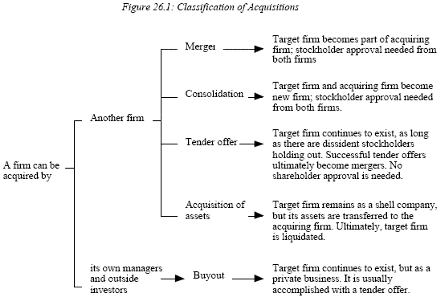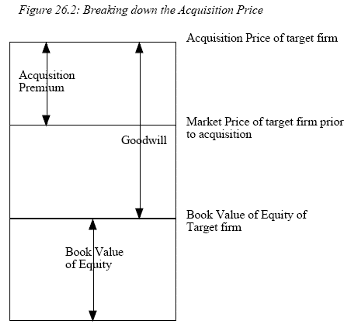When we talk about acquisitions or takeovers, we are talking about a number of different transactions. These transactions can range from one firm merging with another firm to create a new firm to managers of a firm acquiring the firm from its stockholders and creating a private firm. We begin this section by looking at the different forms taken by acquisitions, continue the section by providing an overview on the acquisition process and conclude by examining the history of the acquisitions in the United States
Classifying Acquisitions
There are several ways in which a firm can be acquired by another firm. In a merger, the boards of directors of two firms agree to combine and seek stockholder approval for the combination. In most cases, at least 50% of the shareholders of the target and the bidding firm have to agree to the merger. The target firm ceases to exist and becomes part of the acquiring firm; Digital Computers was absorbed by Compaq after it was acquired in 1997. In a consolidation, a new firm is created after the merger, and both the acquiring firm and target firm stockholders receive stock in this firm; Citigroup, for instance, was the firm created after the consolidation of Citicorp and Travelers’ Insurance Group.
In a tender offer, one firm offers to buy the outstanding stock of the other firm at a specific price and communicates this offer in advertisements and mailings to stockholders. By doing so, it bypasses the incumbent management and board of directors of the target firm. Consequently, tender offers are used to carry out hostile takeovers. The acquired firm will continue to exist as long as there are minority stockholders who refuse the tender. From a practical standpoint, however, most tender offers eventually become mergers, if the acquiring firm is successful in gaining control of the target firm. In a purchase of assets, one firm acquires the assets of another, though a formal vote by the shareholders of the firm being acquired is still needed.
There is a one final category of acquisitions that does not fit into any of the four described above. Here, a firm is acquired by its own management or by a group of investors, usually with a tender offer. After this transaction, the acquired firm can cease to exist as a publicly traded firm and become a private business. These acquisitions are called management buyouts, if managers are involved, and leveraged buyouts, if the funds for the tender offer come predominantly from debt. This was the case, for instance, with the leveraged buyouts of firms such as RJR Nabisco in the 1980s. Figure 26.1 summarizes the various transactions and the consequences for the target firm.

The Process of an Acquisition
Acquisitions can be friendly or hostile events. In a friendly acquisition, the managers of the target firm welcome the acquisition and, in some cases, seek it out. In a hostile acquisition, the target firm’s management does not want to be acquired. The acquiring firm offers a price higher than the target firm’s market price prior to the acquisition and invites stockholders in the target firm to tender their shares for the price. In either friendly or hostile acquisitions, the difference between the acquisition price,and the market price prior to the acquisition is called the acquisition premium.
The acquisition price, in the context of mergers and consolidations, is the price that will be paid by the acquiring firm for each of the target firm’s shares. This price is usually based upon negotiations between the acquiring firm and the target firm’s managers. In a tender offer, it is the price at which the acquiring firm receives enough shares to gain control of the target firm. This price may be higher than the initial price offered by the acquirer, if there are other firms bidding for the same target firm or if an insufficient number of stockholders tender at that initial price. For instance, in 1991, AT&T initially offered to buy NCR for $ 80 per share, a premium of $ 25 over the stock price at the time of the offer.
AT&T ultimately paid $ 110 per share to complete the acquisition. There is one final comparison that can be made, and that is between the price paid on the acquisition and the accounting book value of the equity in the firm being acquired. Depending upon how the acquisition is accounted for, this difference will be recorded as goodwill on the acquiring firm’s books or not be recorded at all. Figure 26.2 presents the break down of the acquisition price into these component parts.

A Brief History of Mergers and Acquisitions in the United States
Merger activity in the United States has occurred in waves, with different motives behind each wave. The first wave occurred in the early part of the 20th century, when companies such as U.S. Steel and Standard Oil were created by acquiring firms within an industry with the explicit objective of dominating these industries and creating monopolies. The second wave coincided with the bull market of the 1920s, when firms again embarked on acquisitions as a way of extending their reach into new markets and expanding market share. During this period, firms such as General Foods and Allied Chemical came into being.
The third wave occurred in the 1960s and 1970s, when firms such as Gulf and Western focused on acquiring firms in other lines of business, with the intent of diversifying and forming conglomerates. The fourth wave of mergers occurred in the mid 1980s, when firms were acquired primarily for restructuring assets and recapitalization. In some cases, the acquisitions were financed heavily with debt and were initiated by the managers of the firms being acquired. This wave reached its zenith with the acquisition of RJR Nabisco by KKR, but waned toward the end of the decade, as deals became pricier and it became more difficult to find willing lenders.
The mergers in the 1990s were in the telecommunications, entertainment and financial services, as firms consolidated to meet new market and technological challenges. Towards the end of the 1990s, the focus of consolidation shifted to the high technology and internet sectors, with firms increasingly using their own stock as currency to finance acquisitions. Interestingly, merger activity seems to increase in years in which the stock market does well, which is counter to what we would expect if the primary motive for acquisitions were undervaluation.
There also seems to be a tendency for mergers to be concentrated in a few sectors; in the early 1980s, many of the mergers involved oil companies, whereas the focus shifted to food and tobacco companies in the latter half of the decade and shifted again to media and financial service firms in the early 1990s.
--> CT 26.1: Merger waves seem to end with excesses – bidders overpaying for companies and paying a hefty price. The restructuring and buyout wave of the 1980s ended, for instance, after several leveraged buyouts towards the end of the decade failed. Why do merger waves crest?
Prof. Aswath Damodaran
Next: Empirical Evidence on the Value Effects Of Takeovers
Summary: Index